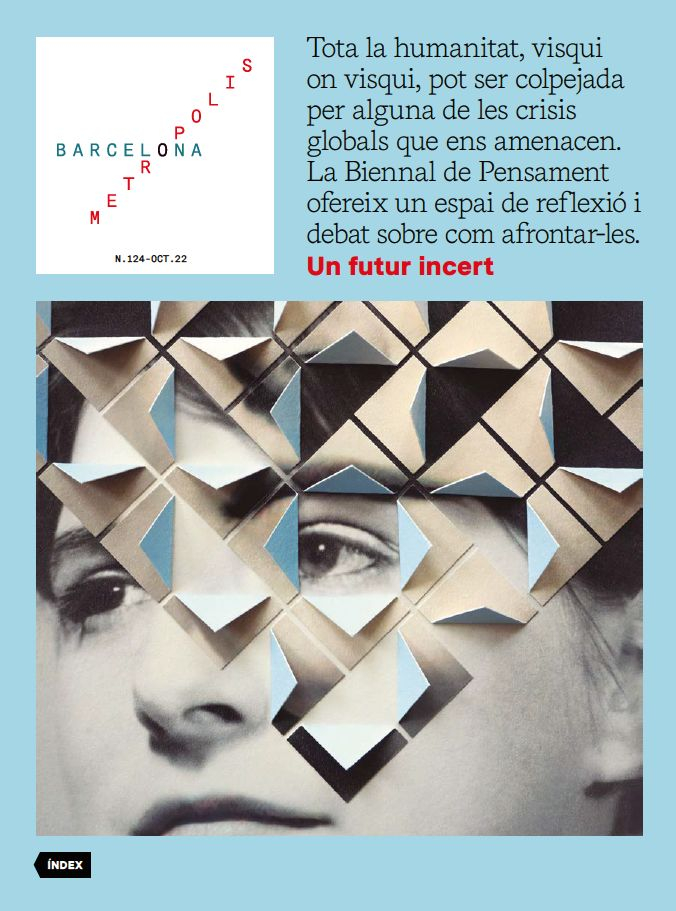Barcelona, capital of comics. Who’s (still) afraid of manga?
- Culture Folder
- Debate
- Oct 22
- 14 mins
We have had access to manga publications for more than thirty years. More and more international publishers are launching new comic collections in general and manga in particular to feed a market that is growing steadily. The Barcelona Manga Fair, which has celebrated 28 editions, is another measure of the success of this kind of comic in terms of sales and the crowds it draws. Experts and professionals from the industry tell us about how they got here and the future awaiting the genre.
Barcelona becomes the capital of manga every year. The Manga Fair, which this year celebrates its 28th edition, has enjoyed five years of recurring success to the point that it has had to change its venue several times to be able to host the number of visitors, besides lengthening the event’s duration. Those who have spent years working within the publishing world are not surprised by the staggering sales figures that manga currently reaps, or that it keeps stealing the limelight in publishing news in the media.
The fact that the success of this genre still comes as a surprise is indicative of the lack of knowledge about the world of comics, in general, and manga (and anime), in particular. And that we are unfamiliar with the kinds of behaviour and tastes related to the entertainment of younger audiences is much more worrying.
Lack of familiarity is what sparks the concern or smugness with which these comics from Japan are often seen and judged, which carry a clichéd image that associates them with children’s content or, diametrically opposed, with high doses of sex and violence. The different narrative of comics and cartoons of European origin has also raised suspicions among older generations towards this form of storytelling that is so radically different in terms of form and content.
Since the early 1970s, the successive waves of hugely successful Japanese material in bookshops (manga) and in the audiovisual sector (anime) make us wonder what sets the current boom apart from the previous ones. One differential factor is that big publishers have launched new and ambitious ranges, such as Penguin Random House’s Salamandra Graphic label. Another noteworthy fact is the resolute commitment of Enciclopèdia Catalana, one of the leading publishing houses, to launch a label with quite a few manga titles exclusively in the Catalan language, in order to fill the current gap in the market.
Regardless of our thoughts on the matter, manga has indeed contributed very positively to the turnover of bookshops and publishers, and it is not a phenomenon exclusive to Spain, but adopts a similar pattern in all Western countries.
Different experts and professionals in the industry give their opinion about the sweet publishing moment being enjoyed by manga (and anime on audiovisual platforms), without forgetting the reasons that, in their opinion, have led to its lasting success, the relationship between manga and anime, the surrounding stereotypes, the influence it exerts on fostering reading among young audiences and, finally, an offshoot unknown to the public at large: winning back female comic readers.

Marc Bernabé
Japanese translator and author of several books on manga
Manga is a well-established genre. It has been published regularly for more than 30 years and is already intergenerational. There are parents who share the reading they enjoyed as children or teenagers with their own children. It is now trendy, accepted and has become part of the collective imagination. Today, most children and teenagers read manga or at least have an interest in it. The pandemic has also played a big part in giving impetus to manga: many people discovered the genre because they had lots of unexpected time on their hands during the lockdown.
When a manga is adapted into an anime, there is a sudden rise in popularity, regardless of the previous success of the manga series. We have seen this with Spy × Family, which is now a huge hit thanks to the anime, but was already selling really well before. A bestseller like Chainsaw Man is certain to see sales multiply when the anime starts airing. Platforms also normalise anime and allow twenty-year-old shows like Naruto to live on and constantly renew their readership.
It is worth highlighting the relationship between manga and female readership, because there have always been works designed specifically for female audiences and women also read manga not necessarily created for them. Thanks to manga, the Western female audience, sidelined in the 1980s and 1990s, could be reinstated.

Oriol Estrada
Content advisor at Comic Barcelona and Manga Barcelona
With manga, a kind of “perfect storm” has been created in Spain. On the one hand, we have editorial diversification, a much more varied range of manga that can attract a very different audience. There are people who read comics, but not manga, and now they have started to give it a try. There are also people who had read manga years ago and are now picking it back up because they find a range that is more suited to their age and interests. Besides that, we have the lockdown effect, which has made the 9 to 12-year-old age bracket discover anime through digital platforms and then make the leap to paper, which we have called ‘coronaotakus’.
What’s more, I believe the role that manga is playing in encouraging reading, for the time being, is vital. We often hear parents saying that their children “don't read”, and later some add that they “only read manga”. It’s even a bit insulting! If manga is currently one of the entry points to the world of reading for many teenagers, let’s make the most of it.
Manga is for children, young people, grown ups, and in Japan it is even for older people, with a range for all kinds of audiences. Manga is sex, it’s violence, and it’s also anti-militarism or LGBTI representation; it has every genre you can imagine, and more. Reducing the world’s most powerful comics industry to stereotypes is something we should have gotten over.
“Manga is sex, it’s violence, and it’s also anti-militarism or LGBTI representation; it has every genre you can imagine, and more.” Oriol Estrada. Comic Barcelona and Manga Barcelona

Pema Maymó
Director of La Galera, the label hosting Kaji, Enciclopèdia Catalana’s Catalan manga series
The success of manga is due to the convergence of two factors: the first generation of manga readers are already adults. They read manga in their teenage years and and now they are passing these habits onto their children or students. Manga and anime are no longer seen as something marginal, but as another dimension of leisure and recreation. The other factor is the incorporation of all Japanese aesthetics into many circuits of everyday life: the clothing designs of low-cost brands, video games…
Although we have a collective image of manga in terms of childishness, sex and violence, inherited from the first animated series we saw, it is a matter of time and the arrival of increasingly different titles for this image to fade. There is a sweeping manga trend that explores issues such as functional or gender diversity in a fairly thorough manner, and that helps readers assimilate and normalise these issues.
In fact, there are publishers that have taken a step forward in importing manga with a female demographic (created in Japan with a female audience in mind), and have started to work hard on bringing back major titles that explore female readers’ nostalgia for the 1990s and 2000s.
What’s more, manga has become a link that connects the child reader with the adult reader, since a large amount of what is imported is aimed at these age groups. We can see it either as a form of identity building in pre-adolescents and adolescents, or as a way of keeping reading as a normalised part of their entertainment and leisure time.

Óscar Valiente
Director of Norma Editorial
The current manga phenomenon is mainly due to the arrival of a whole new generation of readers who have discovered the genre through anime on streaming platforms, and the recommendations made on social networks by their leading points of reference, now known as YouTubers or influencers. Young readers have thus discovered a type of story with which they identify and that they are passionate about.
A good anime series almost certainly leads to a considerable upsurge in the sales of the manga series on which it is based. But the market is so mature that many series without an anime adaptation are still big hits.
What’s more, manga is important because it creates a culture that encourages reading, the care of paper editions, sharing the experience with other readers, visiting bookshops and events… This is something that is very hard to achieve organically; in the past it has been accomplished by phenomena like Harry Potter, and institutions should protect it because today manga is the gateway to the passion for reading for many children and young people.
A factor that sets manga apart from comics in general is that it has many female readers. They account for more than 40% of the total, which is a substantial figure, and the market has been able to respond to their interest by publishing more and more series aimed at female audiences. It should also be noted that many successful series are created by female authors.

Lluïsa Pardo
Librarian specialising in comics at the Ignasi Iglesias Library – Can Fabra
Comic sales grew by 70% during the year 2021, dominated by manga. The same thing applies to loans in the Xarxa de Biblioteques Municipals [Network of Municipal Libraries], which saw an increase of almost 200,000 more loans compared to 2019. And in the Libraries of Barcelona it is the collection that recorded the most movement (the number and percentage of documents out on loan) in 2021. Year after year, manga tops the rankings of the most borrowed material.
Manga is experiencing another boom on a global scale. It continues to be a major cultural and social phenomenon with great international acclaim. It is a market that is steadily growing. Time has shown that it is not just a fad. It has increasingly more readers, and not only does it continue to reach the younger generations, but it is also gaining followers among adult audiences.
It is a valuable resource for making reading more accessible to young people, even among those who show less interest. Comics encourage the initiation to reading, fostering the habit of reading, promoting the learning of various subjects. They are also a good pedagogical resource in the classroom, as a teaching tool and to promote reading. We organise many activities in the library with the purpose of disseminating, promoting and fostering reading and debate on this medium: meetings with authors and specialists, exhibitions, workshops, reading clubs, etc.
“From a certain point in time, the national comic became detached from young people. By contrast, manga has been able to connect with that young, child or teenage reader.” Jordi Canyissà, journalist specialising in comics

Jordi Canyissà
Journalist specialising in comics in La Vanguardia
The connection with young people has proven fundamental in the success of manga. From a certain point in time, the national comic became detached from young people. The comic grew up while the readers became grown ups (in the 1970s and 1980s), but, instead, it lost the connection with new readers, something that Bruguera’s comics had done years ago, for example. It may not have happened in France and Belgium because they still have a huge volume of living classics in bookshops. By contrast, manga has been able to connect with that young, child or teenage reader, presenting them with contemporary stories written in a contemporary language that is understood and with which the reader identifies.
Let’s look at the case of France. The Macron government has created a Culture Pass to spend on cultural products, and the figures show that much of it has been spent on manga. This has sparked a debate between a supposed “high” and “low” culture, although it is not described in these terms, or, if you prefer, a debate between apocalyptics and integrated. Many articles published showed considerable ignorance of culture and young people, literally assuming that reading Proust is incompatible with reading a comic.
In Catalonia, the stereotyped image of manga is related to the first issues that arrived. In 1990, Akira was published, an extraordinary but young and violent series, and from 1992 the famous white series Dragon Ball began to be published. At that time we still didn’t know that there was another kind of manga; this came later, with works like those of Jiro Taniguchi. Later we discovered that there was even an underground manga thanks to figures like Yoshiharu Tsuge, Yoshihiro Tatsumi, Tadao Tsuge and Shin’ichi Abe.

Alfons Moliné
Manga specialist
Relating manga’s success to the existence of anime is too easy. Although the success of Dragon Ball on television did indeed prove conducive to its publication and thus began a serendipitous editorial adventure that is still ongoing, it has not always been the case. For example, Oliver and Benji (Captain Tsubasa) also succeeded on the small screen, but when the publisher Glénat released the manga series, it was not such a hit. Something similar happened with Doraemon. Nowadays, the fragmentation of the audiovisual market, dominated by thematic channels and platforms, has permanently marginalised those heroic times in which the kids gathered in front of the television to watch Club Super 3. But some manga still hold on tight in the market with the support of their respective anime versions, such as Detective Conan, One Piece and My Hero Academia.
Since its advent, the comic has always been a valuable tool to encourage the habit of reading. However, we must not fall into the mistaken belief that comics should be progressively replaced by “real” books, but that both products should exist side by side. This may recall a terrible campaign towards the end of the Franco regime, promoted by the Ministry of Culture at that time (1970s). It proclaimed that “Where there is a comic, there will be a book”, meaning that comics were only reading material for children, which had to be replaced, thus denying the existence of adult comics.
“The labels attached to manga are absurd. No one says that cinema is just for children just because the Disney factor is there, do they?” Anna Abella, journalist specialised in comics

Enric Piñeyro
Manga specialist, former head of the manga section in the Continuarà Cómics bookshop and advisor to the defunct publisher Glénat
The origin of the current manga phenomenon goes way back, and it is not the first time that it has taken place in Catalonia, Spain and the West. Manga arrived in Spain in the 1970s, and during the first decade of the 21st century, it was a phenomenon that took everyone by surprise, including publishers. The main difference between now and what happened some twenty years ago is the easiness offered by the internet today – with all its social networks – to amplify the phenomenon, so that it reaches lots more people.
Manga and anime have always gone hand in hand, except in cases where the success of a television series is reflected in a manga comic that falls short of the anime. In fact, most animated series build on the success of specific series published in Japanese magazines (there are loads and they have huge print runs that would not be feasible here) and are part of a whole project that includes multimedia marketing, merchandising, etc.
The manga phenomenon also has very positive aspects in terms of creating a readership. Young children now have reading material that is more fitting for their age group and there is no longer a need to resort to the old adage “this isn’t for you” or “this is too violent”. Now there is a very wide choice which can reach each kind of audience, since manga production is highly segmented, just like the audience.

Anna Abella
Journalist specialised in comics at El Periódico
There are several factors that made us start marvelling at this sales boom in the autumn of 2021: on account of the lockdown many people, young people and adults, became fans of anime on streaming platforms. This brought lots of people to seek out the manga series they are based on. Many discovered that there is manga for each type of reader (specialised for young girls and boys, secondary school or university students, etc., with themes of horror, sports, erotica, cooking, everyday life, science fiction, etc.). And, unlike superheroes, in which non-expert readers can get confused and not know where to get started because of the huge number of series and staples, it’s easy to get into manga because they are closed collections with a certain number of volumes. Besides that, they are quite affordable in price.
The labels attached to manga are absurd. In the case of books, in general, no one would contemplate using them. There are children’s books, books for young people, erotic literature, crime fiction… all kinds of books in which there is lots of violence and sex, and others in which there’s nothing. Just like no one says that cinema is just for children just because the Disney factor is there, do they?
Young people should read what they want. If they are really into manga now, then that’s fantastic. Japanese comics can play the role that Astérix, Tintin, Mortadelo and Superman comics, now classics, once did.
Just as there are manga in which there are more sexualised female characters to appeal to a male audience, there are also more empowered female leads or complex female characters that young female readers can identify with.
The newsletter
Subscribe to our newsletter to keep up to date with Barcelona Metròpolis' new developments




